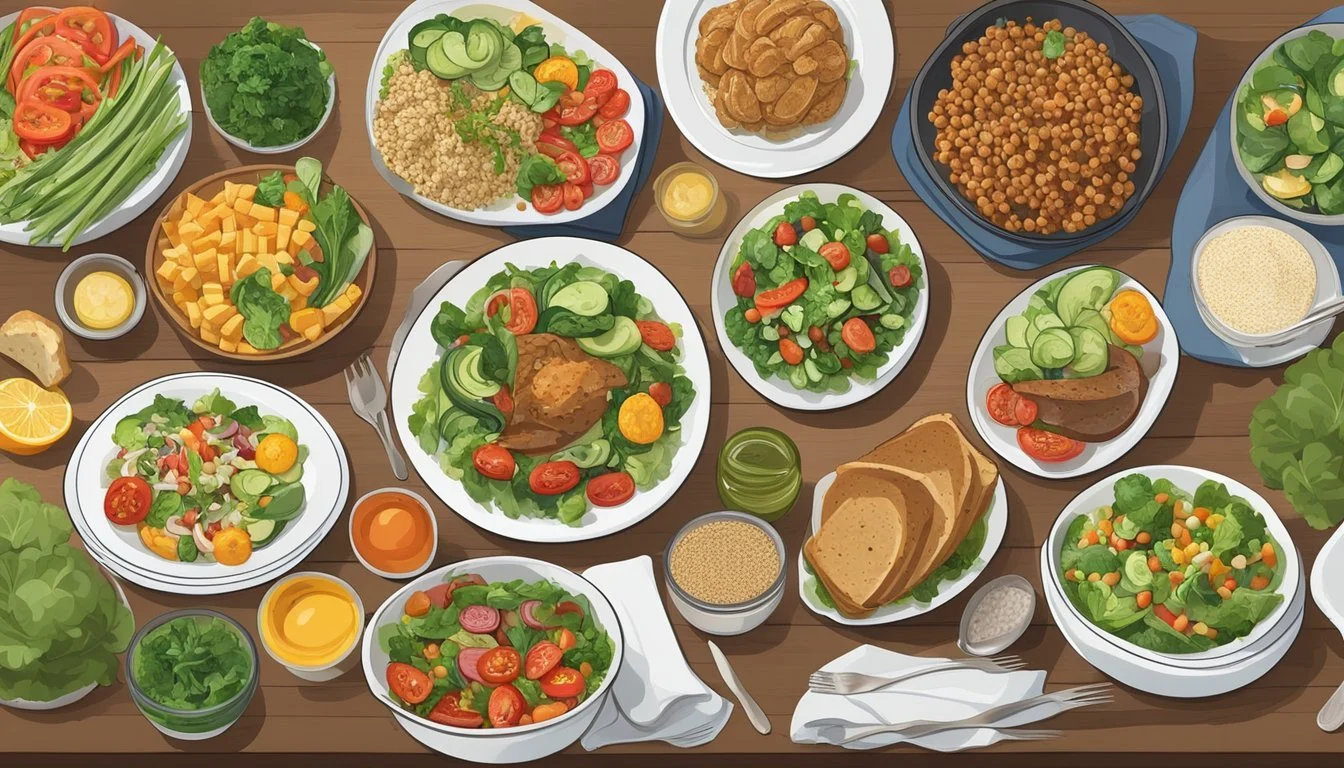Kiwi-Inspired Diabetes-Friendly Dinner Recipes for New Zealand Homes
Managing diabetes through diet is crucial, and finding delicious yet healthy dinner recipes can make a significant difference. In New Zealand, numerous resources offer diabetes-friendly meal ideas that cater to local tastes and ingredients. Diabetes New Zealand provides a variety of recipes on their website, including options for lunch and dinner that are tailored to help maintain stable blood sugar levels.
These recipes often incorporate nutritious ingredients like lean proteins, whole grains, and plenty of vegetables. From hearty soups to flavorful curries, there's no shortage of options for those looking to create satisfying meals while managing their diabetes. Many of these dishes can be prepared quickly, making them ideal for busy weeknights when time is limited but health remains a priority.
Understanding Diabetes and Diet
Diet plays a crucial role in managing diabetes. Proper nutrition helps control blood sugar levels and reduces the risk of complications. New Zealand offers specific dietary guidelines tailored to its population and food culture.
The Role of Diet in Managing Diabetes
Diabetes management heavily relies on maintaining stable blood glucose levels. Food choices directly impact these levels, making diet a cornerstone of diabetes care. Carbohydrates have the most significant effect on blood sugar, but proteins and fats also play important roles.
Dietitians recommend balanced meals that include a mix of nutrients. This approach helps slow down glucose absorption and prevents sharp spikes in blood sugar. Regular meal timing is also crucial for diabetes management.
Portion control is essential. It helps manage calorie intake and weight, both key factors in diabetes care. Eating smaller, more frequent meals can help stabilize blood sugar throughout the day.
New Zealand-Specific Dietary Guidelines
New Zealand's dietary guidelines for diabetes align with international standards but incorporate local food preferences. Diabetes New Zealand provides resources tailored to Kiwi lifestyles and eating habits.
The guidelines emphasize consuming a variety of fruits and vegetables native to New Zealand. They recommend including foods like kumara, kiwifruit, and leafy greens in daily meals.
Lean meats, poultry, and seafood are encouraged as protein sources. New Zealand's abundant seafood options provide excellent omega-3 fatty acids, beneficial for heart health.
Dairy products, an important part of New Zealand's diet, are recommended in low-fat varieties. The guidelines also promote whole grains and legumes as healthy carbohydrate sources.
Principles of a Diabetes-Friendly Diet
A diabetes-friendly diet focuses on nutrient-dense foods that have minimal impact on blood sugar levels. It emphasizes whole, unprocessed foods over refined and sugary options.
Key principles include:
Choosing complex carbohydrates over simple sugars
Including lean proteins in each meal
Incorporating healthy fats from sources like avocados and nuts
Limiting saturated fats and avoiding trans fats
Increasing fiber intake through vegetables, fruits, and whole grains
The Healthy Food Guide provides recipes that align with these principles. These recipes often use low-glycemic index ingredients to help manage blood sugar levels.
Portion control remains crucial. Using smaller plates and measuring servings can help prevent overeating. Balancing meals with appropriate ratios of carbohydrates, proteins, and fats supports overall health and blood sugar management.
Planning Your Diabetes-Friendly Dinner
Creating balanced, satisfying dinners is key for managing diabetes. Careful planning ensures meals provide proper nutrition while maintaining stable blood sugar levels.
Components of a Balanced Dinner
A diabetes-friendly dinner should include lean protein, non-starchy vegetables, and controlled portions of carbohydrates. Lean protein options include chicken, fish, tofu, or lean beef. Fill half your plate with non-starchy vegetables like broccoli, spinach, or bell peppers.
Healthy carbohydrate choices are essential. Opt for whole grains, legumes, or starchy vegetables in moderation. Brown rice, quinoa, lentils, or sweet potatoes are nutritious options. These provide fiber and nutrients while having less impact on blood sugar than refined carbs.
Include healthy fats in small amounts. Avocado, olive oil, or nuts can add flavor and satiety to meals. Combine these components to create diverse, appealing dinners that support blood sugar management.
Serving Sizes and Carbohydrate Counting
Portion control is crucial for diabetes management. Use measuring tools or visual guides to estimate serving sizes accurately. A typical serving of cooked grains or starchy vegetables is 1/2 to 1 cup.
Carbohydrate counting helps maintain consistent blood glucose levels. Aim for 45-60 grams of carbs per meal, adjusting based on individual needs and medical advice. Read food labels carefully to determine carb content.
Track carbs from all sources, including grains, fruits, and dairy. Be mindful of hidden carbs in sauces or dressings. Balancing carbs with protein and fiber can help slow glucose absorption. Regular monitoring and adjusting portions ensures optimal blood sugar control.
Diabetes-Friendly Dinner Recipes
Crafting delicious and nutritious meals is essential for managing diabetes. These recipes focus on lean proteins, complex carbohydrates, and plenty of vegetables to help maintain stable blood sugar levels.
Meat and Poultry Entrées
Lean meats and poultry are excellent protein sources for diabetics. Try a herb-crusted chicken breast with roasted vegetables. Marinate skinless chicken thighs in lemon juice, garlic, and oregano before grilling.
For red meat lovers, a small portion of lean beef stir-fry with colorful bell peppers and broccoli makes a satisfying meal. Pair it with brown rice or quinoa for added fiber.
Turkey meatballs seasoned with sage and thyme, served alongside zucchini noodles, offer a comforting yet low-carb option.
Fish and Seafood Entrées
Fish is rich in omega-3 fatty acids and provides a healthy alternative to red meat. Baked salmon with a citrus glaze and steamed green beans is a simple, nutritious choice.
Grilled shrimp skewers with cherry tomatoes and red onions make a light summer meal. Serve with a small portion of whole grain couscous.
Try a fragrant fish curry using firm white fish, coconut milk, and plenty of vegetables. Opt for brown rice as a side dish to increase fiber intake.
Vegetarian and Vegan Dinner Options
Plant-based meals can be both diabetes-friendly and satisfying. A hearty lentil and vegetable soup provides protein and fiber to help stabilize blood sugar.
Roasted portobello mushroom caps stuffed with spinach and feta cheese offer a meaty texture without the meat.
A colorful stir-fry with tofu, snap peas, carrots, and water chestnuts over cauliflower rice is low in carbs and high in nutrients.
Experiment with a chickpea and vegetable curry served with a small portion of brown rice for a filling vegan meal.
Grain and Bean-Based Dishes
Whole grains and beans are excellent sources of complex carbohydrates and fiber. A quinoa and black bean bowl topped with grilled vegetables and avocado makes a balanced meal.
Try a barley risotto with mushrooms and peas for a comforting yet diabetes-friendly option.
A three-bean chili loaded with bell peppers, onions, and tomatoes provides a protein-packed meal. Serve with a small dollop of Greek yogurt for added creaminess.
Experiment with ancient grains like farro in a Mediterranean-style salad with cucumbers, tomatoes, and a light lemon dressing.
Including Variety in Your Diet
Incorporating diverse foods into diabetes-friendly meals enhances nutrition and enjoyment. Exploring international cuisines and local New Zealand produce opens up exciting possibilities for flavorful, balanced eating.
International Cuisine for Diabetes-Friendly Meals
Asian recipes offer excellent options for diabetes management. Stir-fries combine lean proteins with abundant vegetables, providing fiber and nutrients. Vietnamese rice paper rolls filled with shrimp and fresh herbs make a light, satisfying meal.
Indian curries using lentils and chickpeas offer plant-based protein sources. Greek cuisine features Mediterranean staples like olive oil, fish, and tomatoes, all beneficial for blood sugar control.
Mexican dishes can be adapted by using whole grain tortillas and loading up on vegetables. Italian cuisine shines with tomato-based sauces, grilled seafood, and vegetable-rich minestrone soups.
Expanding Your Palate with New Zealand Produce
New Zealand's diverse climate yields a bounty of fresh produce year-round. Kūmara, a type of sweet potato, is rich in fiber and antioxidants. It can be roasted, mashed, or added to salads for a nutritious boost.
Feijoas offer a unique flavor and are packed with vitamin C. They can be eaten fresh or used in smoothies and baked goods. Kiwifruit provides a low-glycemic fruit option, perfect for snacks or breakfast.
Seasonal vegetables like silverbeet, pumpkin, and courgettes add variety to meals. These can be steamed, roasted, or incorporated into soups and stews. Fresh herbs like coriander and mint enhance flavors without adding extra calories or carbohydrates.
Additional Meal Planning Tips
Effective meal planning is crucial for managing diabetes through diet. These tips focus on healthier recipe modifications and smart cooking methods to help maintain stable blood sugar levels.
Adjusting Recipes for Healthier Alternatives
Replace refined grains with whole grains to increase fiber content. Swap white rice for brown rice or quinoa in stir-fries and casseroles. Use whole wheat flour instead of white flour in baking recipes.
Reduce added sugars by using natural sweeteners like stevia or fruit purees. Replace sugar with mashed bananas or applesauce in muffins and quick breads.
Incorporate more vegetables into meals. Add grated zucchini or carrots to meatloaf or pasta sauces. Use cauliflower rice as a low-carb alternative to regular rice.
Choose lean proteins like skinless chicken, fish, or tofu. Trim visible fat from meats before cooking. Use beans or lentils as plant-based protein sources in soups and salads.
Preparation and Cooking Techniques
Opt for healthier cooking methods like grilling, roasting, or steaming instead of frying. Use a non-stick pan or cooking spray to reduce added fats.
Prepare ingredients in advance to make weeknight cooking easier. Chop vegetables and portion proteins on weekends for quick assembly during busy days.
Use herbs and spices to add flavor without extra calories or sodium. Experiment with garlic, ginger, cumin, or paprika to enhance dishes naturally.
Practice portion control by using smaller plates or measuring tools. Fill half the plate with non-starchy vegetables, a quarter with lean protein, and a quarter with whole grains or starchy vegetables.
Side Dishes and Complements
Choosing the right side dishes is crucial for a balanced diabetes-friendly meal. Nutritious options can help manage blood sugar levels while adding variety and flavor to your plate.
Selection of Diabetes-Friendly Side Salads
Green salads with mixed leafy vegetables provide essential nutrients and fiber. Add cucumber, tomatoes, and bell peppers for crunch and color. Avoid high-sugar dressings; opt for olive oil and vinegar or lemon juice instead.
Bean salads are excellent choices. Combine kidney beans, chickpeas, and lentils for a protein-rich side. Mix with diced onions and capsicum, then dress with a light vinaigrette.
Coleslaw made with low-fat yogurt instead of mayonnaise is a tasty option. Shred cabbage and carrots, then toss with a dressing of yogurt, lemon juice, and a touch of mustard.
High-Fiber Side Options
Roasted vegetables are simple and delicious. Toss cauliflower, broccoli, or Brussels sprouts with olive oil and herbs, then roast until tender. These low-carb options are packed with fiber and nutrients.
Quinoa pilaf offers a whole grain alternative to rice. Cook quinoa in vegetable broth, then mix with sautéed onions, garlic, and diced bell peppers. Add chopped parsley for freshness.
Mashed cauliflower is a great substitute for potatoes. Steam cauliflower florets, then blend with a small amount of low-fat milk and seasonings. This creamy side dish is low in carbs and high in fiber.
Alternative Meal Options
Managing diabetes extends beyond dinner choices. A balanced approach to all meals and snacks helps maintain stable blood glucose levels throughout the day.
Diabetes-Friendly Breakfasts and Lunches
Breakfast options include whole grain toast with avocado and poached eggs. This combination provides fiber, healthy fats, and protein. Overnight oats made with low-fat milk, chia seeds, and berries offer a quick, nutrient-dense start to the day.
For lunch, try a quinoa salad with grilled chicken, mixed vegetables, and a lemon vinaigrette. Whole grain wraps filled with tuna, lettuce, and tomato make a portable option. Vegetable-based soups paired with a small whole grain roll provide warmth and satiety.
Greek yogurt parfaits layered with nuts and fresh fruit serve as a balanced meal or substantial snack. These choices help regulate blood sugar while providing essential nutrients.
Healthy Snacking Choices
Smart snacking plays a crucial role in diabetes management. Raw vegetable sticks with hummus offer crunch and protein. A small handful of unsalted nuts provides healthy fats and helps curb hunger.
Apple slices with a tablespoon of peanut butter combine fiber and protein. Hard-boiled eggs make convenient, protein-rich snacks. Low-fat cheese with whole grain crackers offers calcium and complex carbohydrates.
For sweet cravings, try a small serving of berries or a square of dark chocolate. These options satisfy without causing rapid blood sugar spikes. Homemade trail mix with nuts, seeds, and a sprinkle of dried fruit provides energy and nutrients.
Conclusion
Diabetes-friendly dinner recipes in New Zealand offer a wealth of flavorful and nutritious options. The Diabetes New Zealand website provides a variety of meal ideas tailored to those managing diabetes.
Recipes like chunky corn and ham chowder, savoury parcels, and chicken kumara salad demonstrate the diversity available. These dishes balance taste and health, helping individuals maintain blood sugar levels while enjoying satisfying meals.
New Zealand's culinary landscape incorporates local ingredients and international influences, resulting in unique diabetes-friendly creations. Emphasizing fresh produce, lean proteins, and whole grains, these recipes support overall health and diabetes management.
Exploring diabetes dinner recipes allows for creativity in the kitchen while adhering to dietary guidelines. By embracing these meal options, individuals can take control of their nutrition and enjoy delicious dinners that align with their health goals.









